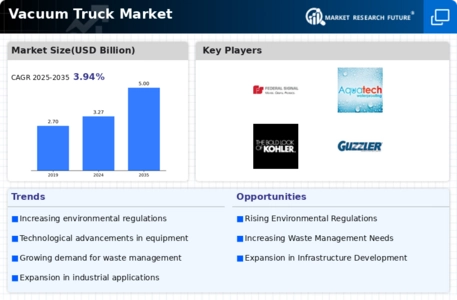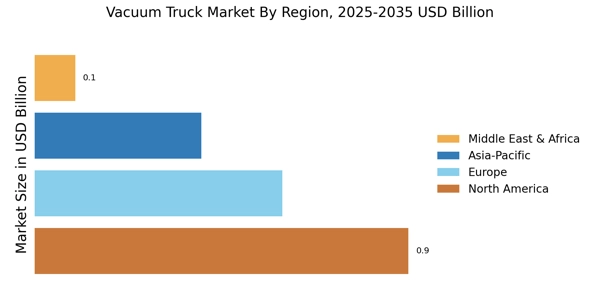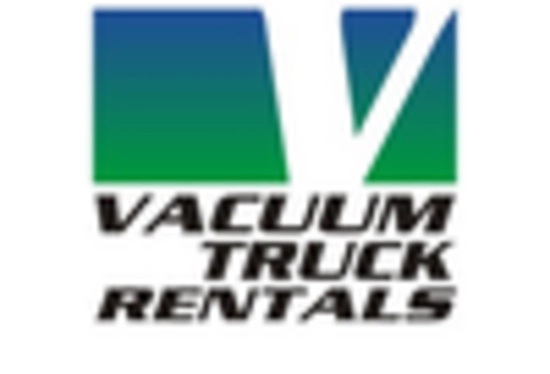The Vacuum Truck Market is currently characterized by a dynamic competitive landscape, driven by increasing demand for efficient waste management solutions and environmental regulations. Key players such as Vacuum Truck Market Rentals (US), Guzzler Manufacturing (US), and Federal Signal Corporation (US) are strategically positioning themselves through innovation and regional expansion. Vacuum Truck Market Rentals (US) focuses on enhancing its rental fleet with advanced technology, while Guzzler Manufacturing (US) emphasizes product innovation to meet diverse customer needs. Federal Signal Corporation (US) is leveraging partnerships to expand its service offerings, collectively shaping a competitive environment that prioritizes technological advancement and customer-centric solutions.
In terms of business tactics, companies are increasingly localizing manufacturing to reduce costs and optimize supply chains. The market appears moderately fragmented, with several players vying for market share. However, the collective influence of major companies is significant, as they drive industry standards and innovation. This competitive structure allows for a variety of offerings, catering to different segments of the market, from municipal services to industrial applications.
In August 2025, Guzzler Manufacturing (US) announced the launch of its latest vacuum truck model, which incorporates advanced filtration technology aimed at enhancing operational efficiency and reducing environmental impact. This strategic move not only positions Guzzler as a leader in sustainable practices but also addresses the growing regulatory pressures for cleaner operations in the waste management sector. The introduction of this model is likely to attract environmentally conscious customers and strengthen Guzzler's market presence.
In September 2025, Federal Signal Corporation (US) entered into a strategic partnership with a leading technology firm to integrate AI-driven analytics into its vacuum truck operations. This collaboration aims to optimize fleet management and improve service delivery. By harnessing AI capabilities, Federal Signal is poised to enhance operational efficiency and provide customers with data-driven insights, thereby reinforcing its competitive edge in the market.
In July 2025, Vacuum Truck Market Rentals (US) expanded its operations into the Canadian market, establishing a new rental facility in Toronto. This expansion reflects the company's strategy to tap into emerging markets and diversify its customer base. By localizing its services, Vacuum Truck Market Rentals can better cater to regional demands and enhance its service offerings, which may lead to increased market share in North America.
As of October 2025, the Vacuum Tanker Market is witnessing trends such as digitalization, sustainability, and the integration of AI technologies. These trends are reshaping competitive dynamics, with companies increasingly forming strategic alliances to enhance their technological capabilities. The shift from price-based competition to a focus on innovation and supply chain reliability is evident, suggesting that future differentiation will hinge on technological advancements and sustainable practices.
In October 2025, The Toro Company announced the acquisition of Tornado Infrastructure Equipment Ltd., strengthening its presence in infrastructure and equipment solutions. The deal expands Toro’s portfolio and enhances market reach in professional-grade machinery. It supports long-term growth in global equipment markets.
Recently, Vermeer announced the acquisition of Australia-based Vac Truck Industries, adding specialised vacuum excavation equipment to its global machinery portfolio. The deal strengthens Vermeer’s offerings in environmental and utility service equipment.


















Leave a Comment